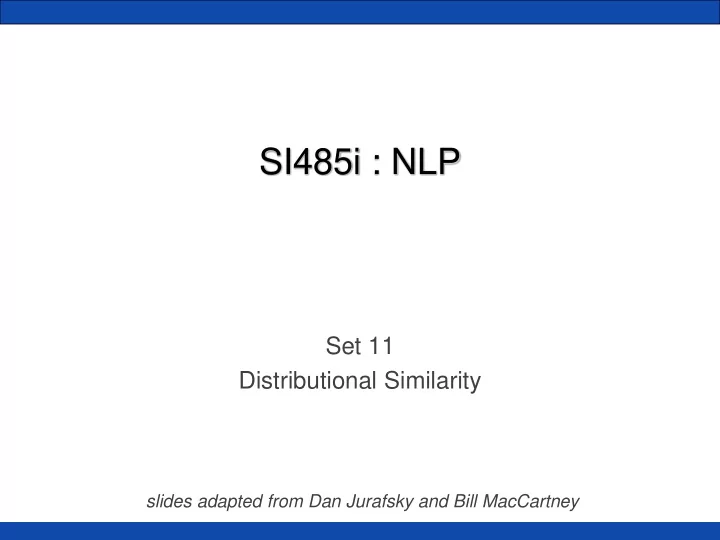

SI485i : NLP Set 11 Distributional Similarity slides adapted from Dan Jurafsky and Bill MacCartney
Distributional methods • Firth (1957) “You shall know a word by the company it keeps!” • Example from Nida (1975) noted by Lin: A bottle of tezgüino is on the table Everybody likes tezgüino Tezgüino makes you drunk We make tezgüino out of corn • Intuition: • Just from these contexts, a human could guess meaning of tezgüino • So we should look at the surrounding contexts, see what other words have similar context
Fill-in-the-blank on Google You can get a quick & dirty impression of what words show up in a given context by putting a * in your Google query: “drank a bottle of *” Hi I'm Noreen and I once drank a bottle of wine in under 4 minutes SHE DRANK A BOTTLE OF JACK ?! harleyabshireblondie. he drank a bottle of beer like any man I topped off some salted peanuts and drank a bottle of water The partygoers drank a bottle of champagne . MR WEST IS DEAD AS A HAMMER HE DRANK A BOTTLE OF ROGAINE aug 29th 2010 i drank a bottle of Odwalla Pomegranate Juice and got ... The 3 of us drank a bottle of Naga Viper Sauce ... We drank a bottle of Lemelson pinot noir from Oregon ($52) she drank a bottle of bleach nearly killing herself, "to clean herself from her wedding"
Context vector • Target word w • Suppose we had one binary feature f i for each of the N words v i in the lexicon • “ word v i occurs in the neighborhood of w ” • w = (f 1 , f 2 , f 3 , …, f N ) • If w = tezgüino , v 1 = bottle , v 2 = drunk , v 3 = matrix • w = (1 , 1, 0, … )
Intuition • Define two words by these sparse feature vectors • Apply a vector distance metric • Call two words similar if their vectors are similar
Distributional similarity We just need to specify 3 things: 1. How the co-occurrence terms are defined 2. How terms are weighted • (Boolean? Frequency? Logs? Mutual information?) 3. What vector similarity metric should we use? • Euclidean distance? Cosine? Jaccard? Dice?
1. Defining co-occurrence vectors • We could have windows of neighboring words • Bag-of-words • We generally remove stop words • But we lose any sense of syntax • Instead, use the words occurring in particular grammatical relations
Defining co-occurrence vectors “The meaning of entities, and the meaning of grammatical relations among them, is related to the restriction of combinations of these entitites relative to other entities.” Zellig Harris (1968) Idea: parse the sentence, extract grammatical dependencies
Co-occurrence vectors based on grammatical dependencies For the word cell : vector of N × R features ( R is the number of dependency relations)
Exercise • Search “Naval Academy” and create a vector. • What other school is most similar? Most different? • Compare vectors 10
2. Weighting the counts (“Measures of association with context”) • We have been using the frequency count of some feature as its weight or value • But we could use any function of this frequency • Let’s consider one feature f = (r, w ’) = ( obj-of, attack ) • P(f | w) = count(f, w) / count(w) • Assoc prob (w, f) = p(f|w)
Frequency-based problems Objects of the verb drink : Water 7 Champagne 4 It 3 Much 3 Anything 3 Liquid 2 Wine 2 • “drink it” is more common than “drink wine” ! • But “wine” is a better “drinkable” thing than “it” • We need to control for expected frequency • Instead, normalize by the expected frequency
Weighting: Mutual Information • Pointwise mutual information : measure of how often two events x and y occur, compared with what we would expect if they were independent: • PMI between a target word w and a feature f :
Mutual information intuition Objects of the verb drink
Summary: weightings • See Manning and Schuetze (1999) for more
3. Defining vector similarity
Summary of similarity measures
Evaluating similarity measures • Intrinsic evaluation • Correlation with word similarity ratings from humans • Extrinsic (task-based, end-to-end) evaluation • Malapropism (spelling error) detection • WSD • Essay grading • Plagiarism detection • Taking TOEFL multiple-choice vocabulary tests • Language modeling in some application
An example of detected plagiarism
Recommend
More recommend